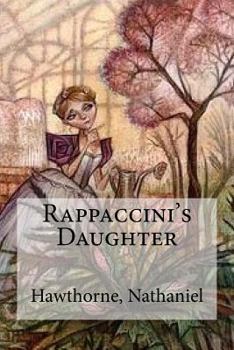Rappaccini's Daughter
Select Format
Select Condition 
Book Overview
How is this book unique? Font adjustments & biography included Unabridged (100% Original content) Formatted for e-reader Illustrated About Rappaccini's Daughter by Nathaniel Hawthorne "Rappaccini's... This description may be from another edition of this product.
Format:Paperback
Language:English
ISBN:1536868329
ISBN13:9781536868326
Release Date:August 2016
Publisher:Createspace Independent Publishing Platform
Length:36 Pages
Weight:0.14 lbs.
Dimensions:0.1" x 6.0" x 9.0"
Customer Reviews
4 ratings
Evil must be your only happiness
Published by Thriftbooks.com User , 16 years ago
The three short stories in this book give a perfect flavor of N. Hawthorne's masterful literary art: social relevance, psychological insight, irony, sarcasm, allegoric and symbolic power. In `Rappaccini's Daughter', a beautiful garden (`Was this garden the Eden of the present world?') contains only poisonous flowers. Its gardener is a physician whose experiments serve only his diabolic and morbid goal of total control over his daughter. In `Young Goodman Brown', a young man undergoes the hallucination of a black mass `by a score of the church members of Salem village'. Its aim is `to penetrate the deep mystery of sin.' He will be marked for the rest of his life. `A Select Party' is held in a castle in the air. Those invited are `fantastic masquers, rendering heroism and nature alike ridiculous': the representative of Posterity (`I expect to owe you nothing, unless it be certain national debt'), Master Genius, Man of Fancy, but also `such rarities in the world as an incorruptible Patriot, a Priest without worldly ambitions, a Poet who felt no jealousy or a Reformer untrammeled by his theory.' Vanitas vanitatum revisited. These literary gems should not be missed.
Rappaccini's Daughter
Published by Thriftbooks.com User , 17 years ago
The short story written by Nathaniel Hawthorne reeks with the theme of the ability to accept what is good and bad in humanity. The story pretty much alludes to the biblical story, with Giovanni and Beatrice starring as Adam and Eve respectively. The two scientists pretty much juxtapose each other, while Baglioni views things superficially only being able to see, Beatrice for what she is made of rather than what her character is like Rappaccini is much in tune with nature, not realizing the plights of what he made her to be out of, but what she is to him, perfection. Perfection cannot exist in the world. Because after that there is no meaning, nothing can be done after that because there is nothing higher. Both young and beautiful, Giovanni and Beatrice meet in the gardens, alluding to the garden of Eden. The catch is that in this garden, the plants are toxic, with the ability to kill anyone who touches them. Only Beatrice can hold them because she is made out of them. However, Giovanni does not see this until towards the end. His views on her entirely change from being an angel to corrupt. He is not able to compromise between the two, and cannot see past her flaws although she has good intentions. This brings Beatrice into despair and she impulsively takes an antidote that would cure her of her evil. However, relating back to the theme of the inability to compromise, because she was too much intertwined with the poison as her life force, the antidote, the common representation of good, kills her. Much of Nathaniel Hawthorne's writing is littered with ambiguity, as implied in his use of setting. There are three main colors prevalent throughout the story, which are yellow, purple, and black, each of them representing the different levels of good to evil. Yellow, the color of the sun, represents the mirage of the unspoiled nature of the garden, it gives the shrubbery a peaceful nature, connoting innocence. With the color of purple, as seen in Beatrice's flower and attire, is ambiguous. It alludes to the Advent, the hiatus of when Christ was born to cleanse the world of its sins. It could represent Hawthorne's message of the endless wait for our quest to perfection, so the best possible course is to accept and deal with imperfections. Lastly, the color of black, of darkness, and of evil, and if yellow is the positive overtone then black is the negative one foiling the yellow. I found this story to be marked up entirely with ambiguity, from the dialogue to the settings. This "open to interpretation feeling" left me quite dissatisfied and frustrated. However, this could also be related to Hawthorne's message of having to deal with our frustration and learn to live with it. This story should definitely be read as it provides an insightful view on mankind and its fallacies.
short but sweet review
Published by Thriftbooks.com User , 20 years ago
fantastic short story! Stevie Nicks based her song 'running through the garden' on this book, its a must hear!!
Hawthorne Rules
Published by Thriftbooks.com User , 20 years ago
I love Rappaccini's Daughter! It is one of the best short stories I have ever read.





